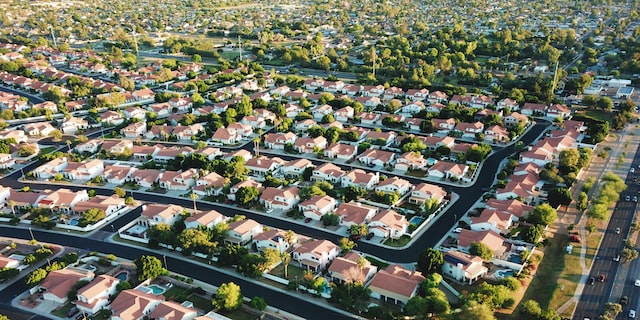Where are US Citizens Living & Working After COVID?
The impact of the pandemic can still be felt on multiple fronts, almost three years after its emergence in early 2020. One of the most noticeable of these impacts has been the proliferation of remote work and its influence on where people choose to live and work. Not so long ago, most people chose where they lived based on where they worked or where their industry was focused. Fast forward to the end of 2022, and it’s no longer as cut and dry as it once was.
In recent years, large cities and their suburban rings have lost some of the appeal that previously allowed them to attract employees and homeowners. Today, the rise of remote work and the decentralization of talent that it provides has given way to a surge in demand for both residential and commercial properties in areas that had previously flown under the radar.
Some pundits are saying that these changes are here to stay, so the question is – where are people living and working in a post-pandemic United States?

Contents
- 1 Mobility Trends in 2021 and 2022
- 2 Other Factors Influencing Mobility
- 3 From Urban to Suburban, and Back Again
- 4 Housing Affordability and Rents
- 5 Livable, Affordable Cities and Zoom Towns
- 6 The Texas Boom Towns
- 7 Walkable Urban Housing Demand
- 8 Are Companies Staying Put or Relocating Their HQs?
- 9 Conclusions
Mobility Trends in 2021 and 2022
During the height of the pandemic, a trend emerged that saw workers moving away from urban centers and into cheaper areas, largely as a result of the locational freedom afforded by the remote work status-quo. Considering the length of the pandemic, and the uncertainty swirling around a ‘return to normal’, many leapt at the opportunity to relocate to cheaper locations to give themselves a better quality of life.
Surprisingly, evidence shows that people who might’ve previously resided in high-density urban environments were simultaneously eager to move back to busier locations. This unique situation resulted in a reversal to step migration (the universal phenomena of rural populations moving step-by-step towards centers of growth) not seen since the term was coined post-Industrial Revolution.

Fleeing Big Cities for Cheaper Suburbs
Seeing the writing on the wall, many people opted to leave big cities for rural areas and outer suburbs when the pandemic first hit in early-2020. Despite the vast majority of this group likely expecting this move to be a temporary one, census data from April 2022 shows that many have settled in these locations permanently. Additionally, the U.S. Census Bureau also released findings highlighting that a high volume of Americans have maintained the locational preferences that they established throughout the pandemic, citing affordability and better walking access to core amenities as a key factor keeping them from returning to major cities.
Some of the reasons for Americans moving away from large cities – such as expensive housing and increased remote work opportunities – are more apparent now. As more and more industries become open to long-term remote working, the migration of workers from major costal cities to smaller, more affordable locations could significantly change the American economy of the future.
Further, the end of pandemic lockdowns hasn’t stopped the migration of people away from some major coastal cities. In fact, many of these urban centers are continuing to lose high numbers of residents as we get closer to the start of 2023.
For example, the U.S. Census Bureau reported that Los Angeles had 179,000 residents leave between 2020 and 2021. New York City also lost about 113,000 people to outward migration during the same period. Additionally, the U.S. Census Bureau estimated a 6.7% drop in the population of San Francisco between April 2020 and July 2021, from approximately 874,000 to 815,000.
According to a recent report, the average price of rent for city living was $1,579 per month in 2019, while suburbs were significantly cheaper at $1,404. Today, however, these numbers have flipped, as city prices decreased at an average of 2.5% YOY during the pandemic, while suburban rents increased by 3.9%. These trends exemplify shifting preferences away from city living.

Other Factors Influencing Mobility
Space
The longer that people were isolated in home offices, the longer they had to think about how little living space they actually had. Many professionals, now forced to spend extended periods of time in their homes, found themselves struggling to operate in inner-city dwellings without defined workspaces or multiple living areas.
According to Chris Leinberger, professor emeritus at GWU’s Center for Real Estate and Urban Analysis: “In 2020, a fair chunk is saying, ‘I want to get out of the city, and I want to have more space. The reality of needing space at home, to work from home – that’s real.”
And now, especially for white collar and knowledge workers where WFH, remote and hybrid scheduling is continuing to be more of a long term option, maximizing living space is becoming more of a pressing concern going forward.
Urban Decline
The decline of employment opportunities, closure of restaurants, and limited opening hours of shops, left many inner-city residents feeling uneasy about continuing to live and work downtown. Even now, as a lot of urban areas recover from the worst of the pandemic, memories are still fresh of how bad it got, making suburban and rural living stand out as an appealing alternative to numerous people.

From Urban to Suburban, and Back Again
During the pandemic, vacancy rates in urban areas rose by almost 200 basis points (BPS). As of Q3 2021, vacancy averaged roughly 5%, only 70 bps higher than before the emergence of COVID-19, and was predicted to drop to 4% by the end of 2022. In contrast, suburban properties seemed to be insulated from this rise due to a combination of factors, such as income insecurity, a preference for outdoor activities, and more millennials with young families required close access to schools. These factors, combined with the realities of the pandemic, drove demand for properties in less crowded and more affordable submarkets.
The rental market is somewhat returning to its pre-2020 state, with core urban areas beginning to see more growth than their suburban counterparts. In a July 2022 report, median rent growth was up 12.8% in cities compared to 11.7% for suburbs – a sign that people are once again moving back to larger metropolitan areas.
Unfortunately for those late to the party and only now considering a move – either to the suburbs, or to take advantage of a city’s pandemic exodus, the report claims that suburban renting won’t become more affordable anytime soon. Danielle Hale, Chief Economist at Realtor.com attests to the returning general desire for urban locales: “The days of smaller premiums for downtown rentals are numbered,” said Hale, “as a return to in-office work and city life is sparking a relative uptick in urban rent growth.”
With the ending of pandemic restrictions, more people are returning to downtown areas and filling up multifamily properties. This is due in part to higher vaccination rates, greater comfort with using public transit, reopened higher-learning campuses, and the slow return of workers resuming a traditional in-person 9-5.
At the beginning of 2022, CBRE forecasted that urban multifamily occupancy levels would stay above 95% for the foreseeable future, and that net effective rents would grow by 7% throughout 2022; strongly indicating a recovered interest in inner-city dwellings.

Housing Affordability and Rents
US housing prices have increased tremendously over the past 30 years, more than tripling from $150,000 in 1992 to over $500,000 earlier this year. This growth has been especially explosive in the Sun Belt. For example, in Florida’s Cape Coral, housing prices rose by the largest percentage of any U.S. city between May 2020 and May 2022. Other cities where prices have seen similar levels of increase include Austin, Dallas, Boise, Phoenix and several cities in Utah.
A startling statistic shows the depth of the housing affordability crisis. Between December 2020 and December 2021, median U.S. home values grew by $52,667 – outpacing the earnings of the median worker, who only made $50,000 in that timespan. This occurred in 25 of the 38 major U.S. metro areas. In 11 markets specifically, home values appreciated by more than $100,000; meaning houses in these top-tier markets effectively earned twice as much money as American workers did.
In some highly sought-after cities in the Sun Belt, prices have increased to the point where they’re now more costly than prominent gateway cities. Miami is a perfect example – becoming America’s least affordable housing market. As of February 2022, the median asking price in Miami was $589,000, juxtaposed to a median income of only $43,401.
Homeownership is more common among wealthier and advantaged Americans. On the other hand, renting is much more prevalent for less fortunate citizens and younger people. Unfortunately for these cohorts, rental prices have recently exploded – matching or exceeding mortgage growth, and increasing by 350% since 1980. From May 2021 until May 2022 alone, rents increased nation-wide by a whopping 15%, now averaging over $2,000 a month.

Livable, Affordable Cities and Zoom Towns
According to Dr. Greg Howard, a professor at the University of Illinois Urbana-Champaign’s Department of Economics, growth in “livable and affordable” cities – like Boise, Idaho, and Austin – was on the rise even before COVID hit and has since skyrocketed during the pandemic.
“This is what new data is beginning to confirm,” said Howard. “It looks more and more likely that this will become a long-term trend – people being able to live where they want to live instead of just where they have a job.”
We have been hearing a lot about the lingering effects of the pandemic, and how it’s affected where people choose to live and work – especially coinciding with the prevalence of remote working. The population movements have been particularly noticeable with the ascendancy in recent years of Sun Belt tech hubs like Austin and Miami, as well as in rural Zoom Towns like Truckee, California and Bozeman, Montana.

The Texas Boom Towns
Despite the population gains and general growth of cities previously mentioned, the vast majority of the country pales in comparison to Texas’ recent boom.
In 2021, five counties in Texas were in the top 10 fastest-growing counties in the United States. Coming in at number two was Collin County, with an increase of 36,000 people from 2020. Fort Bend County followed close behind in fourth place, Williamson County came in fifth, and Montgomery County placed eighth on the list, seeing 24,000 new residents make the move last year.
Austin, Texas’ capital city, is located in both Williamson County and Travis County. Electric automaker Tesla relocated to Austin from Palo Alto, California last year. Santa Clara County, where Palo Alto is located, experienced the seventh-largest numeric decline in population of any county in the United States.
Out of all U.S. metros, the top 10 list of areas seeing the greatest numeric population growth from 2020 to 2021 included three Texas metros – Dallas-Fort Worth, Austin, and San Antonio.

Walkable Urban Housing Demand
Chris Leinberger, professor emeritus at GWU’s Center for Real Estate and Urban Analysis, provided insight on continuing priorities for particular types of dwellings.
“What we have seen over the last 25 years is an explosion in demand for walkable urban stuff, whether that be high density, high-rise condos or town houses,” and this is apparent “not just because of how much is being built, but also by the price premiums,” which have exploded in recent years for walkable property close to local amenities, across the U.S.
“It still costs twice as much to buy a for-sale walkable urban house, condo or town house than it does for a drivable suburban,” Leinberger continued. “The market in 2022 is still saying that people are willing to pay twice as much money to be able to walk to restaurants, their kids can walk to school, and they feel more connected with society.”

Are Companies Staying Put or Relocating Their HQs?
Mobility changes haven’t only happened at the household level in recent years. Businesses, particularly those that are office-based, have also reconsidered the need for physical space given the widespread adoption of remote work.
An earlier report from Cushman & Wakefield in 2021 highlights some data in this respect. Despite partial closures and a clear downturn evident during the height of the pandemic, commercial real estate in the gateway markets (Boston, New York, Washington DC, Chicago, San Francisco, and Los Angeles) did not experience major changes in terms of the total proportion of leases signed in comparison to the national market.
The relative stability of these top-tier markets could be explained due to the local presence of corporate headquarters in these cities. Even with interstate relocations (mainly out of California), aspirational destination markets are persistently chosen for many headquarters, resulting in the overall proportion barely changing. Even after the worst of the pandemic was over, approximately one third of all headquarters were still based in California, Texas, Illinois, and New York.
In these markets, city center leases accounted for 40% of total leasing activity – even during the worst of the pandemic. The historical percentage of CBD leases has fluctuated between 39% and 42% since 2018, so the 40% figure is well within the average. In 2021, the main change came as a result of an uptick in CBD leases of Grade A prime office space, both in gateway markets and nearby areas.
All of these statistics point to the continued relevance of and preference for gateway markets when it comes to the HQs of major corporations. Even with reduced floor plates and abundant downsizing, a steady and permanent contingent of workers will always look to live in close enough proximity to these markets to commute and occupy these major workspaces.

Conclusions
Market forecasts suggest continued demand in gateway markets, both for residential and commercial properties, mainly due to strong job growth predictions. However, growth is likely to take place at different rates across the country. For example, it may be faster in Southern states and the Sun Belt, whilst also being likely to lag behind in the Midwest and the Northeast.
In the office market particularly, the biggest improvements will be seen for Grade A, well-equipped spaces in gateway and gateway-adjacent markets. The flight-to-quality that was an evident trend in 2021 will continue beyond 2022, with world-class amenities and perks now serving as a cornerstone of the workplace experience.
It’s evident that the events of the last three years have clearly changed the way that Americans think about where they want to live and work moving forwards, however, it’s still far too early to determine whether the changes observed in this time will be permanent or not. Make sure to tune in this time next year to see if there’s more clarity for the future picture of where people will continue to live and work in the post-pandemic U.S.
Further Insights
Looking for more articles about the US market and general office matters? You can find a number of recent posts below! Alternatively, if you’re a business or freelancer looking for flexible workspace in the US, we can help to connect you to a wide range of serviced offices and coworking spaces in highly sought-after locations such as New York City, Los Angeles, Houston, Atlanta, Miami, Chicago, and Dallas. You can also call us to have a discussion about your requirements on 972-913-2742 or reach out to us on Facebook and Twitter.
A Full Guide to Commercial Lease Assignment (Lease Transfer)
Miami Office Market Report | Q2-Q3 2022
Mid-2022 Las Vegas Office Market Report
The Impact of Proptech on Commercial Real Estate
15 In-Person Employee Recognition Ideas for the New World of Work
Mid-2022 Houston Commercial Real Estate Market Report
Coworking Space for Students on U.S. College Campuses
How the Decentralization of Cities Has Changed the U.S. Office Space Market
US Office Market Trends 2022 – Statistics, Challenges and Outlook
A Full Guide to LEED Certification